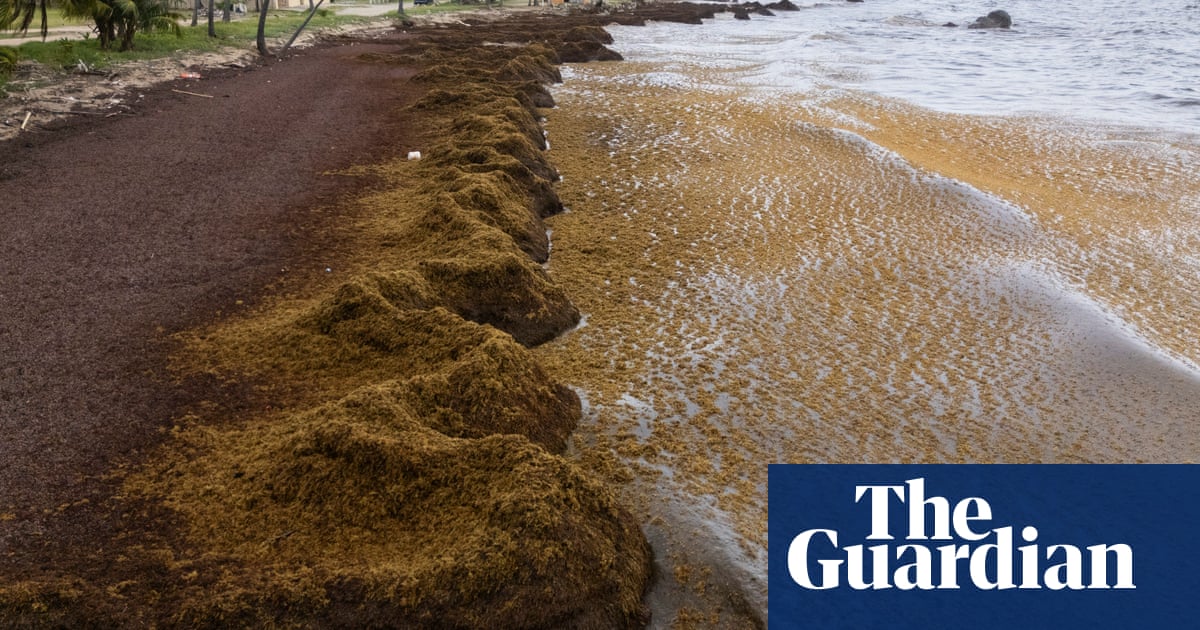A record amount of sargassum has piled up across theCaribbeanand nearby areas in May, and more is expected this month, according to a new study.
The brown prickly algae is suffocating shorelines from Puerto Rico to Guyana and beyond, disrupting tourism, killing wildlife and even releasing toxic gases that forced one school in the French Caribbean island of Martinique to temporarily close.
The amount – 38m tonnes – is the biggest quantity of algae observed across the Caribbean Sea, the western and eastern Atlantic and the Gulf of Mexico since scientists began studying the Great Atlantic Sargassum Belt in 2011, said Brian Barnes, an assistant research professor at the University of South Florida who worked on the new report from the University of South Florida’s Optical Oceanography Lab.
The previous record was set in June 2022 , with some 22m tonnes.
“The peaks just seem to keep getting bigger and bigger year after year,” he said.
But scientists don’t know why yet.
“It’s the million-dollar question,” he said. “I don’t have a supremely satisfying answer.”
Three different types of sargassum exist in the Caribbean and nearby areas, reproducing asexually as they remain afloat thanks to tiny air sacs. They thrive in different ways depending on sunlight, nutrients and water temperature, factors that scientists are currently studying, Barnes said.
Experts have also said that agricultural runoff, warming waters and changes in wind, current and rain could have an effect.
While large clumps of algae in the open ocean are what Barnes called a “healthy, happy ecosystem” for creatures ranging from tiny shrimp to endangered sea turtles, sargassum near or on shore can wreak havoc.
It can block sunlight that coral reefs need to survive, and if the algae sinks, it can smother reefs and sea grasses. Once it reaches shore, the creatures living in the algae die or are picked off by birds, Barnes said.
Huge piles of stinky seaweed also are a headache for the Caribbean, where tourism often generates big money for small islands.
In the popular tourist spot of Punta Cana in the Dominican Republic, officials have invested in barriers to prevent sargassum from reaching the shore.
In the Dutch Caribbean territory of Sint Maarten, crews with backhoes were dispatched in late May as part of an emergency cleanup after residents complained of strong smells of ammonia and hydrogen sulfide, which can affect a person’s respiratory system.
“The smell is quite terrible,” Barnes said.
Meanwhile, in the French Caribbean, officials expect to soon use storage barges and an upgraded special vessel that can collect several tonnes of seaweed a day.
The sargassum “disfigures our coasts, prevents swimming and makes life impossible for local residents”, the French prime minister, François Bayrou, recently told reporters.
But Comito said such vessels were “massively expensive” and not a popular option, noting that another option – using heavy equipment – is labor-intensive.
“You have to be careful because there could be sea turtle eggs affected,” he said. “It’s not like you can go in there and massively rake and scrape the whole thing.”
Some Caribbean islands struggle financially, so most of the cleanup is done by hotels, with some offering guests refunds or a free shuttle to unaffected beaches.
Every year, the amount of sargassum expands in late spring, peaks around summer and starts to decline in the late fall or early winter, Barnes said.
The new record is likely to be broken – experts said they expect even more sargassum for June.
